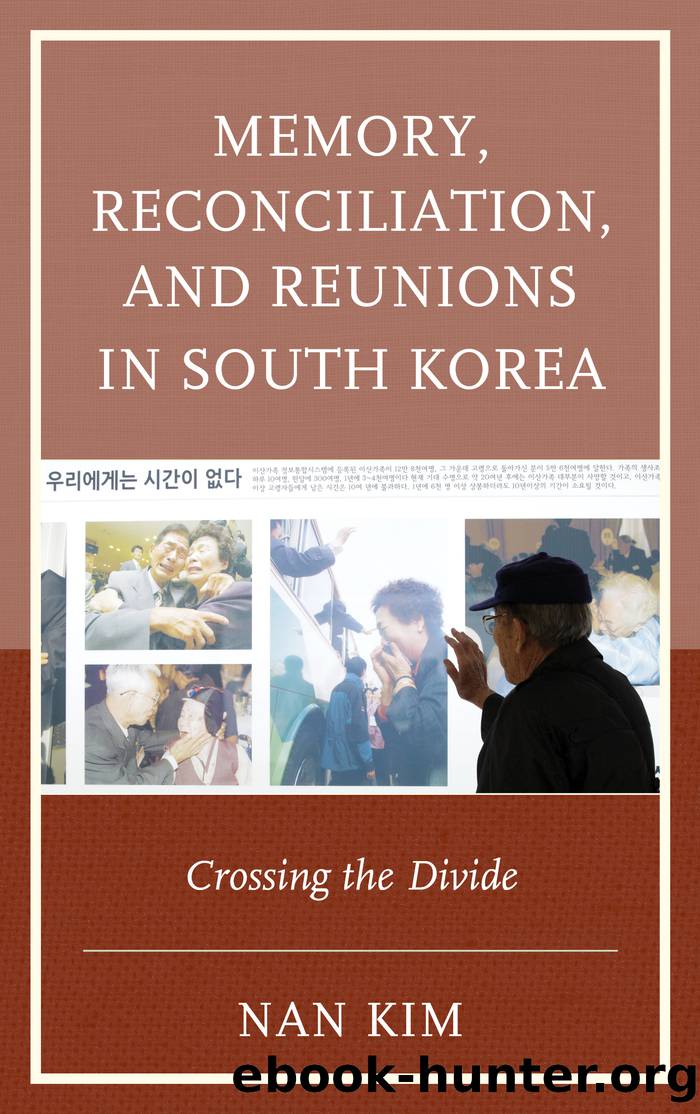Memory, Reconciliation, and Reunions in South Korea by Kim Nan;

Author:Kim, Nan;
Language: eng
Format: epub
Tags: undefined
Publisher: Lexington Books/Fortress Academic
Published: 2012-08-15T00:00:00+00:00
Ironic Visibility
At the moment when interest and visibility surrounding the issue of wartime family separation reached its peak in South Korea, those who became featured as the iconic âseparated familiesâ in media images and press accounts were those who, prior to that point, would not have even been recognized as belonging to the sympathetic nationalist category of âseparated familiesâ (isanâgajok). How did this ironic reversal occur? Such a turnabout is all the more striking when one considers that formerly non-normative and marginalized families became highly visible, while the former normative families became relatively obscured in the coverage of these events. That is, simultaneously with the Seoul reunions, a similar event of separated-family reunions was occurring in Pyongyang among one hundred visiting South Koreans, each of whom would also meet five of their relatives.
The reunions in Pyongyang were broadcast with far less fanfare, and that footage was delayed in part due to technical reasons. While there were also highly emotional scenes of tearful reunions in Pyongyang, the South Korean print and broadcast news outlets largely downplayed them, focusing instead on those held in Seoul.
This disparity in exposure stemmed in part from the discrepancy in logistical support for the journalists covering the events. Only twenty South Korean journalists were permitted to travel with the delegation that went to Pyongyang. In contrast to the many press restrictions in North Korea, the pool of reporters in Seoul had far greater access and freedom to shoot extensive on-site footage of the family meetings. The broadcasts of events taking place in Pyongyang would prove to be noticeably more subdued, compared to the relatively unrestrained and sensationalized reporting of events in Seoul, which also became the focus of the reunionsâ international media coverage.
Demographics also played a role in the disproportionate emphasis placed on the meetings in Seoul. The candidates for the reunions in South Korea were chosen by computer based on an algorithm that weighted criteria based on their age and the closeness of their relationship, with highest priority accorded to the elderly and those with parent-child ties. Therefore, those selected in the Southâmost of whom were in their late seventies and eightiesâwere too old to have surviving parents in the North. In what had initially appeared to be one exception, a seventy-six-year-old man residing in Busan was informed that he could expect to meet his mother, receiving the incredible news that she was still alive at the age of 110. Yet, within days, those reports of his motherâs survival were found to be in error. Among the South Korean delegation who went to Pyongyang for reunions, all parent-child reunions therefore involved South Koreans meeting with their children in Pyongyang. Rather than joyous occasions, these meetings carried overtones of guilt for the parents who had left their offspring behind, even when the circumstances of separation were unavoidable due to the chaos of war. Such fraught emotional burdens posed considerable challenges for the media because the members of these families were far less inclined to be interviewed or to speak in front of the camera.
Download
This site does not store any files on its server. We only index and link to content provided by other sites. Please contact the content providers to delete copyright contents if any and email us, we'll remove relevant links or contents immediately.
The Radium Girls by Kate Moore(11652)
100 Deadly Skills by Clint Emerson(4712)
The Templars by Dan Jones(4564)
Rise and Kill First by Ronen Bergman(4559)
The Doomsday Machine by Daniel Ellsberg(4263)
The Rape of Nanking by Iris Chang(4033)
Killing England by Bill O'Reilly(3903)
Hitler in Los Angeles by Steven J. Ross(3811)
Stalin by Stephen Kotkin(3733)
12 Strong by Doug Stanton(3426)
Hitler's Monsters by Eric Kurlander(3179)
Blood and Sand by Alex Von Tunzelmann(3072)
Darkest Hour by Anthony McCarten(3023)
The Code Book by Simon Singh(2884)
The Art of War Visualized by Jessica Hagy(2847)
Hitler's Flying Saucers: A Guide to German Flying Discs of the Second World War by Stevens Henry(2634)
Babylon's Ark by Lawrence Anthony(2447)
The Second World Wars by Victor Davis Hanson(2429)
Tobruk by Peter Fitzsimons(2384)
